Donate
| CHAPTER 5. | CREW DRILL |
| Section I. | Purpose, organization, and duties |
| Section II. | Light weapon system, XM28 (&-man squad} |
| Section III. | Heavy weapon system, XM29 (5-man squad) |
| Section IV. | Light weapon system, XM28 (3-man squad) |
| Section V. | Heavy weapon _system, XM29 (3 man squad) |
SECTION I. PURPOSE, ORGANIZATION, AND DUTIES
103. Purpose
a. Crew drill develops teamwork in putting the weapon into action with precision and speed. Precision is ahieved by adherence to prescribed training procedures, and when this has been achieved, work is begun on speeding up the process.
b. Squad members should be rotated frequently during drill so each squad member may become proficient in the duties of other members.
c. Precision and teamwork must not be sacrificed for speed. (During crew drill, members move from one position to another at double time. Unless otherwise directed, perform initial training for precision at quick time.)
d. In general, the organization of squads, equipment carried by individuals, and duties performed by squad members are the same for both light and heavy weapons. Differences in organization, equipment, or procedure will be pointed out in succeeding paragraphs where appropriate.
e. To insure proficiency in operation and maintenance of squad communication equipment, the equipment is used frequently during drill.
f. Due to construction of the nuclear projectile, it is necessary to set timer dial before projectile is attached to launching piston. Once loaded, to change timer dial setting, projectile must be removed from weapon.
g. With the XM28 light weapon, to prevent disturbing the lay of the weapon after fire has been adjusted, the nuclear projectile is loaded before fire for adjustment is started.
104. ORGANIZATION
a. Lightweight Weapons Systems XM28 (5-man squad)
|
b. Heavy Weapons Systems XM29 (5-man squad)
|
c. Lightweight Weapons Systems XM28 (3-man squad)
| Squad Member | Individual Load | Equipment Operated |
d. Heavy Weapons Systems XM29 (3-man squad)
| Squad Member | Individual Load | Equipment Operated |
105. Duties of Squad Members (5-Man Squad)
a. Squad Leader.
(1) Commands squad and is responsible for : its equipment. He is qualified to make recommendations! as to the employment of his squad and to observe, adjiJSt, control, and supervise conduct of fire.
(2) During crew drill, requires sight changes (simulated registration) prior to simulated firing of nuclear projectile.
(3) Makes frequent check to insure fire data jS computed and applied to weapon accurately.
(4) Requires all safety checks be made each t:ime the weapon is mounted.
b. Gunner.
(1) Lays weapon for direction and places firing data on sight unit. He measures angle-of-site and ma1ces sight adjustments as directed by the squad leader or computer. He makes his safety checks (par. 52) and fir"es major caliber weapon.
(2) Repeats all commands which contain data applied to the sight unit and/or instructions for laying weapon for direction. He announces UP when ready' to fire and ON THE WAY immediately after firing.
c. Assistant Gunner.
(1) Drives weapon carrier in light and airborne squads. He assists in mounting the weapon, selects correct propellant charge, announces temperature of propellant powder, and loads propellant charge. He sets fuze arming time, attaches 279-mm projectile to piston, sets height-of-burst and arm-safe switches, and inspects dimple motors. He loads and fires spotting rifle and coordinates his movements and duties at the weapon with nu\nbers 1 and 3.
(2) Announces READY each time the spotting rifle is prepared to fire and fires on command of the squad leader or computer. He repeats all commands pertaining to propellant charge, timer-dial, and height of burst.
(3) He removes firing mechanism and makes required safety checks (par. 52).
d. Loader. Drives Ml13 and airborne squad's second vehicle of squad. He loads launching piston, assists in loading 279-mm projectile, places out aiming posts, lays wire, and operates communication equipment.
e. Computer. Operates plotting board, map, aiming circle, and communication equipment. In the absence of the squad leader, assumes command of the squad.
106. Duties; of Squad Members (3-Man Squad)
a. Squad Leader.
(1) Commands squad and is responsible for its equipment. He is qu 1alified to make recommendations as to the employment; of his squad and to observe, adjust, control, and supervise conduct of fire.
(2) During crew drill, he requires sight changes (simulated registration) prior to simulated firing of nuclear projectile.
(3) He makes frequent check to insure fire data is applied to weapon accurately.
(4) He requires all safety checks be made each time the weapon is mounted.
(5) He op1erates plotting board, map, aiming circle, and communication equipment. He computes firing data and issues fire command, computes subsequent data and issues subsequent fire command. He repeats angle-of-site and powder temperature and announces ON THE WAY to FO each time the weapon is fired.
b. Gunner.
(1) Lays weapon for direction and places firing data on sight unit. He measures angle-of-site and makes sight adjustments as directed by the squad leader. He makes his safety checks (par. 52) and fires major caliber weapon. He assists in mounting tripod and attaching projectile to piston launcher.
(2) Repeats all commands which contain data applied to the sight unit and/or instructions for laying weapon for direction. He announces UP when ready to fire and ON THE WAY immediately after firing.
c. Assistant (funner.
(1) Drives weapon carrier. He assists in mounting the weapon, selects correct propellant charge, determines temperature of propellant powder, and loads propellant charge and launching piston. He sets fuze arming time, assists in loading 279-mm projectile, attaches 279-mm projectile to piston, sets height-of-burst and arm-safe switches, and inspects dimple motors. He loads and fires spotting rifle and coordinates his movements and duties at the weapon with the gunner. He places out direction stake and aiming posts, lays wire, and operates communication equipment.
(2) He announces READY each time the spotting rifle is prepared to fire and fires on command of the squad leader. He repeats all commands pertaining to propellant charge, timer dial, and height of burst.
(3) He removes firing mechanism and makes required safety checks (par. 52).
SECTION 11. LIGHT WEAPON SYSTEM, XM28 (5-MAN SQUAD)
107. Port-a-Pack When light weapon is carried on pack boards (fig. 59), the squad performs crew drill in the following manner :
a. Forming for Crew Drill. Normally, the squad is formed only for changes in duty assignments.
(1) The squad leader takes position and commands FORM FOR CREW DRILL. All crew members form in one rank, six paces from and centered on the squad leader.
(2) The squad leader commands GROUND EQUIPMENT. The crew members ground their packs directly to their front (fig. 60). When removing packs, numbers 1 and 2 assist each other as do 3 and 4.
(3) To assign duties for crew drill, squad leader commands COUNT OFF. The squad counts off from right to left, starting with number 1, the gunner.
b. Examining Equipment. Equipment is normally examined one time during each drill period. The squad leader commands EXAMINE EQUIPMENT BEFORE FIRING. Squad members examine equipment as follows:
(1) Squad leader.
(a) Checks binoculars for proper operation.
(b) Checks radio for proper operation.
(c) Checks map to insure coverage of area.
(d) Checks compass for proper operation.
(e) Checks to insure firing tables are correct.
(2) Gunner.
(a) Separates load from pack.
(b) Checks barrel and chamber of weapon to insure they are free of foreign objects and in serviceable condition.
(c) Checks barrel and chamber of spotting rifle (XM69) to insure they are free of foreign objects, that firing mechanism, breech, and extractor are operational, and that spotting rifle is secure in its mount.
(d) Checks fine elevation and traversing mechanisms for proper operation.
(e) Checks sight unit for proper operation.
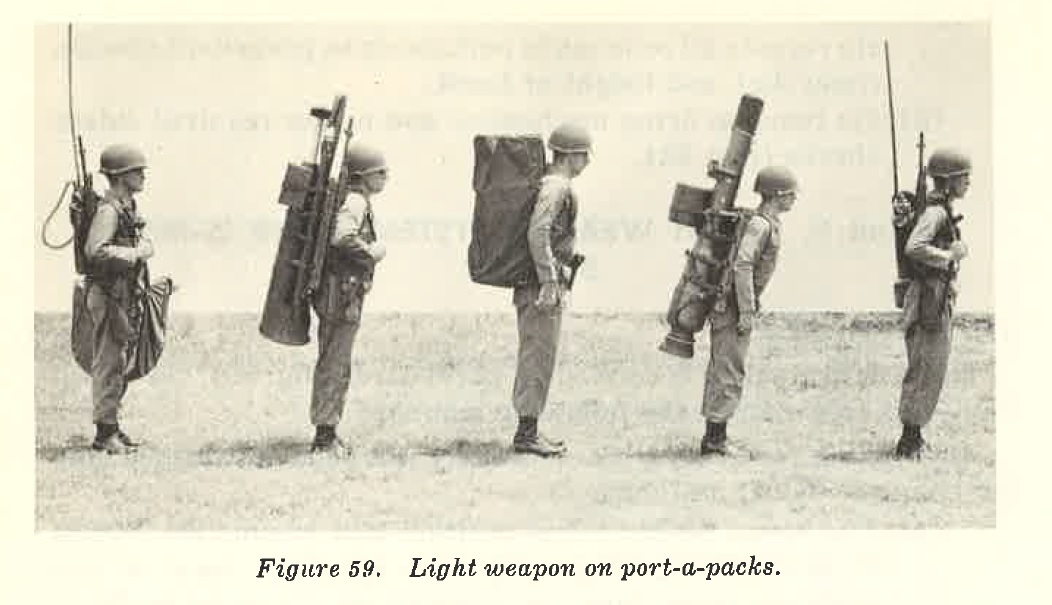
FIGURE 59. Light weapon on port-a-pack.

FIGURE 60. Equipment grounded.
(f) Checks compass for proper operation.
(3) Assistant gunner.
(a) Separates load from pack.
(b) Checks to insure there is no damage to the outside. of nuclear projectile.
(c) Checks timer dial to see it is set on SAFE ( S) position.
(d) Insures arm-safe switch is set on SAFE position.
(e) Insures height-of-burst switch is set on LO position.
(f) Insures dimple motors do not protrude from recesses.
(4) Loader.
(a) Separates load from pack.
(b) Checks tripod, piston propellant charge, 20-mm ammunition, and aiming posts.
(c) Checks thermometer for proper operation.
(5) Computer.
(a) Checks to insure map coverage of area.
(b) Checks radio for proper operation.
(c) Checks to insure proper firing tables.
(d) Checks serviceability of plotting board.
c. Reporting. When all equipment is examined, the following reports are given:
(1) The loader reports MOUNT AND AMMUNITION CORRECT.
(2) The assistant gunner reports AMMUNITION CORRECT.
(3) The gunner reports GUN CORRECT.
(4) The computer reports ALL CORRECT.
108. Placing the Light Weapon into Action From Port-a-Packs to Ground Mount
a. General.
The weapon may be placed into action in either a direct or indirect fire role. The fire command issued by the squad leader indicates the method of employment. Crew drill includes mounting, laying for direction, loading, and fire adjustment (1-8, fig. 61).
b. Direct Fire.
(1) The squad leader moves to a position six steps to the right flank of squad and issues a direct fire command. Example: FIRE MISSION, WEAPON TO BE MOUNTED HERE (Points), FRONT, TROOPS, ONE FIVE HUNDRED, ACTION.
(2) Squad members repeat elements of the fire command as follows:
(a) FIRE MISSION-computer.
(b) GUN TO BE MOUNTED HERE-loader (points).
(c) FRONT-gunner.
(d) TROOPS-gunner.
(e) ONE FIVE HUNDRED-gunner and computer.
(f) ACTION-computer.
(3) On the command ACTION, the loader with tripod moves to the position designated by the squad leader and places it on the ground with the rear legs pointing in the direction of fire. The loader and assistant gunner extend the rear legs until the leg locking plunger snaps into position, attach the cross-tube assembly, connect the struts, and set the tripod in its upright position.
(4) The loader checks the shoes on the rear legs to insure they are not canted, locks the front leg in its halfway position, positions the gimbal ring and pulls out the two quick-release pins, and assists the gunner in attaching the barrel to the tripod.
(5) The gunner inserts the muzzle of the weapon into the gimbal ring, pushing it forward until the loader pusher in on the quick-release pins. The gunner inserts the elevating tube into the cross-tube assembly and locks it in place.
(6) The assistant gunner removes the thermometer from the propellant and announces the temperature reading to the computer. TEMPERATURE PLUS (MINUS) He loads the propellant into the weapon.
(7) The computer repeats the temperature reading and records it.
(8) The loader moves the piston .to the weapon's position and allows the assistant gunner to inspect the obturator rings and rubber gasket making sure the openings in the rings are separated 180°. He then loads the piston into the weapon making sure the index tabs on the piston properly engage the key way slots on the barrel.
(9) The gunner attaches the sight, making sure it is firmly seated, places 3,200 mils on the azimuth scale and O on the azimuth micrometer scale, and lays on the target by directing assistant gunner to move rear legs of tripod right of left.
(10) The loader moves the 279-mm projectile to the weapon and removes the antenna dome cover.
(11) The gunner levels both bubbles and by turning the angle of-site knob, places the horizontal cross line on the center mass of the target. He announces the angle-of-site as plus or (minus) mils as indicated on the angle of-site scales.

FIGURE 61 - 1.
(12) The computer repeats the angle-of-site and, using firing tables, computes and announces the elevation.
(13) The gunner repeats the elevation and applies it to the sight. (At this time the position of the front leg is determined (par. 54.))
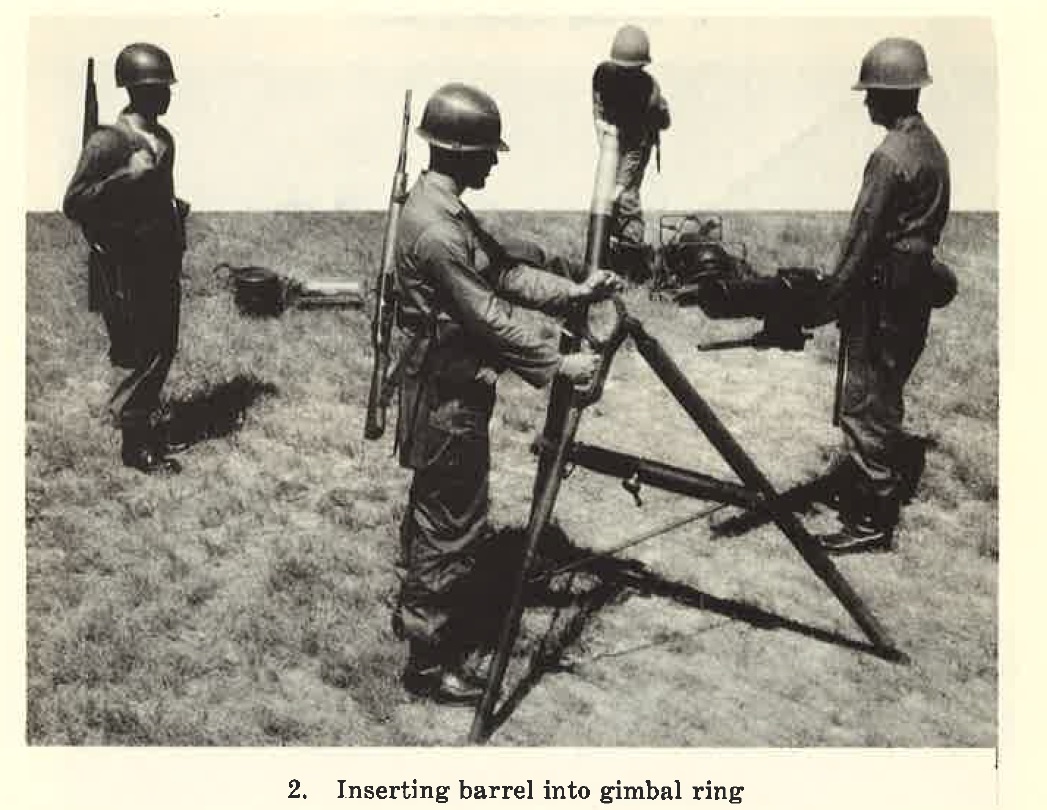
FIGURE 61 - 2. (continued)
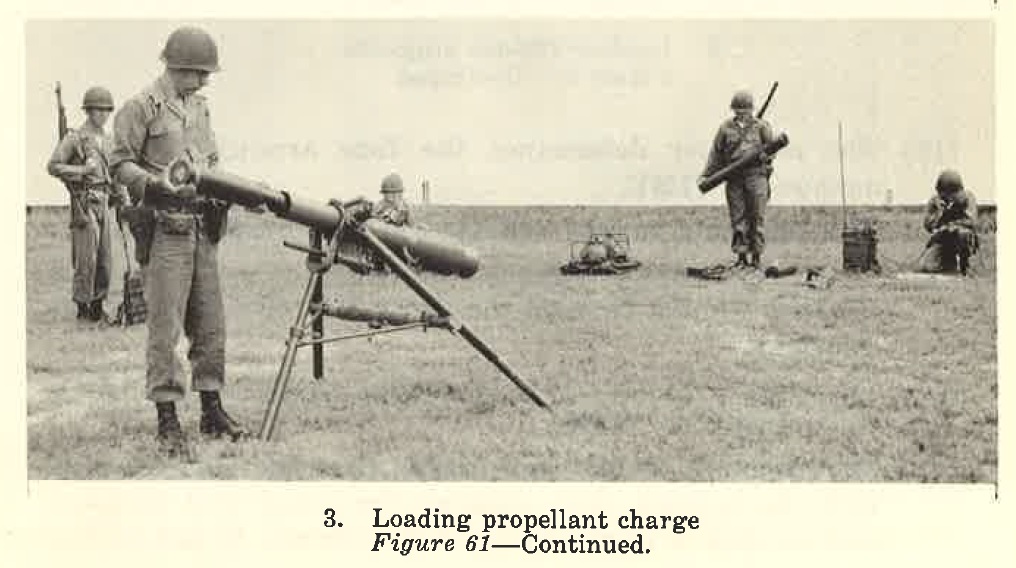
FIGURE 61 - 3. (continued)
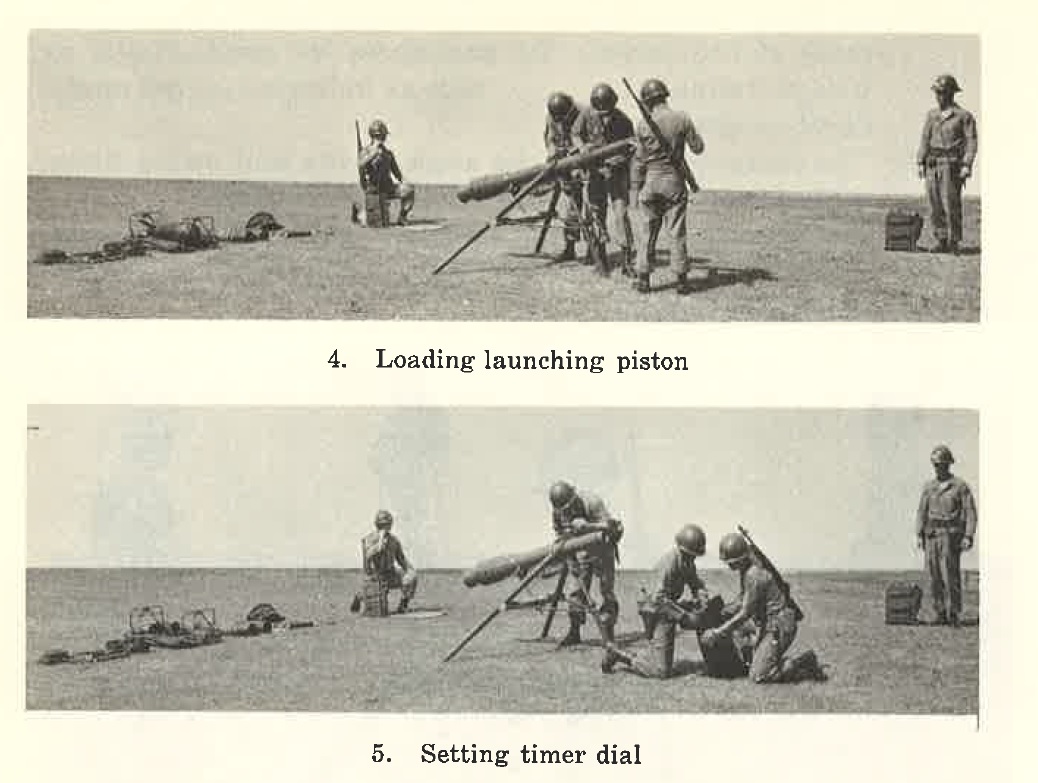
FIGURE 61 - 4. (continued)
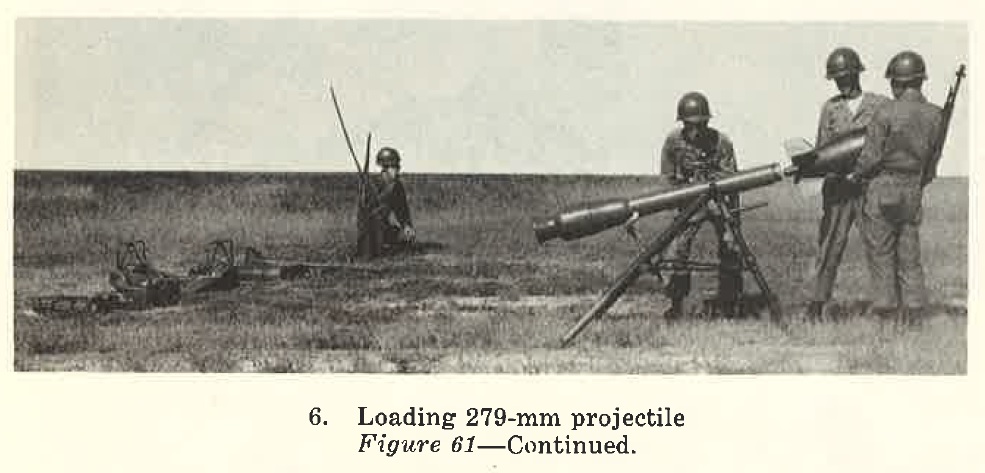
FIGURE 61 - 5. (continued)
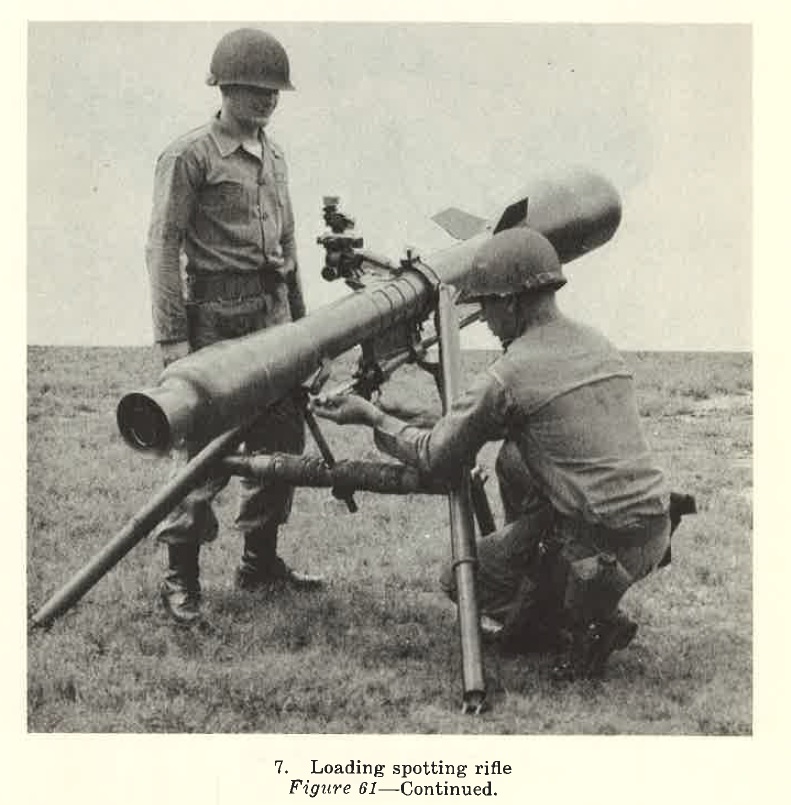
FIGURE 61 - 6. Loading 279 mm Projectile (continued)
(14) The computer determines the fuze arming time and announces TIME.
(15) The assistant gunner repeats the fuze arming time.
(16) Using the spanner wrench, the assistant gunner places the fuze arming time on the timer dial, turning the dial clockwise.
(17) The gunner moves to the projectile, checks time setting, and announces TIME.
(18) The assistant gunner and loader aline the bayonet pins with the bayonet slots, pushing the round well forward and turning it clockwise until it is firmly locked to the piston with no visible gap showing. (Do not use fins of projectile as hand grips when handling.)
(19) The loader removes packs and other equipment from the weapon's position and checks the back blast area.
(20) The assistant gunner loads the spotting rifle and announces READY. He then assists the gunner to relay on the target by moving the coarse elevation and traversing mechanism as directed and keeping the sight cross leveled.
(21) The gunner relays onto the target by using the small deflection and elevating knobs or by directing the assistant gunner to move the weapon right or left, up or down, steady or hold, until the vertical cross line is centered on the target and both bubbles are leveled. He then announces UP.
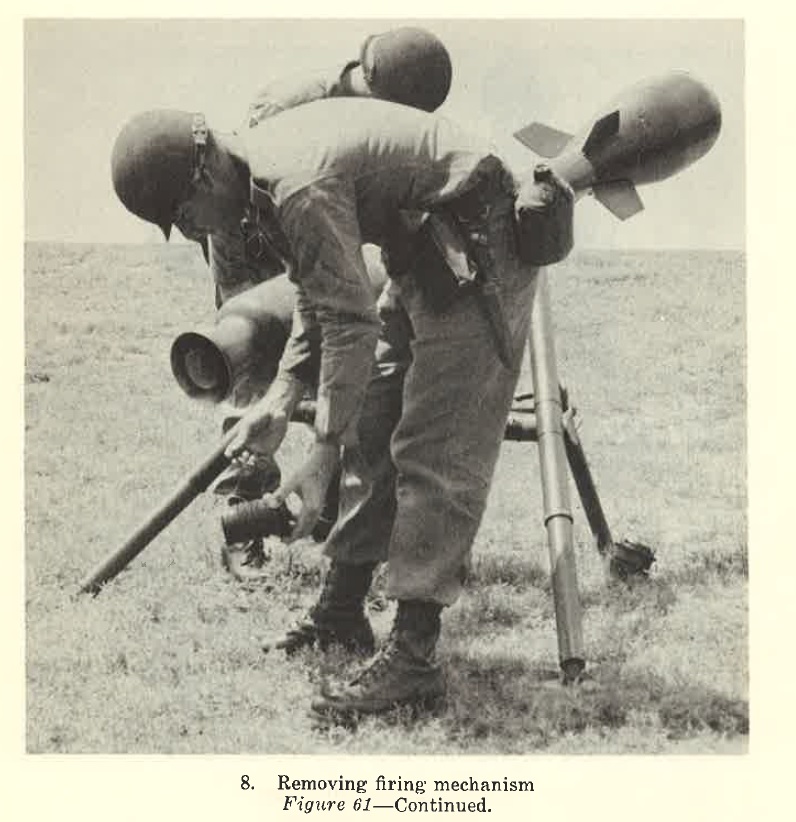
FIGURE 61-7. Loading spotting rifle (continued)
(22) The computer commands FIRE.
(23) The assistant gunner fires the spotting rifle and immediately extracts the expended round. He checks the index tabs of the piston to see they are still engaged with the key way slots, and that the round is still firmly locked to the piston. He determines this by observing the position of the fins in relation to the barrel of the spotting rifle. (Fins must not mask spotting rifle.)
c. Projectile, Atomic, Super caliber, 279-mm, Dummy, XM421. When fire has been adjusted on target using spotter ammunition, to simulate firing and nuclear projectile, the procedure is as follows:
(1) The squad leader issues a subsequent fire command, DUMMY, HI (LO), ADD (DROP).
(2) The gunner, using burst-on-target, corrects for deflection.

FIGURE 61-8. (continued)
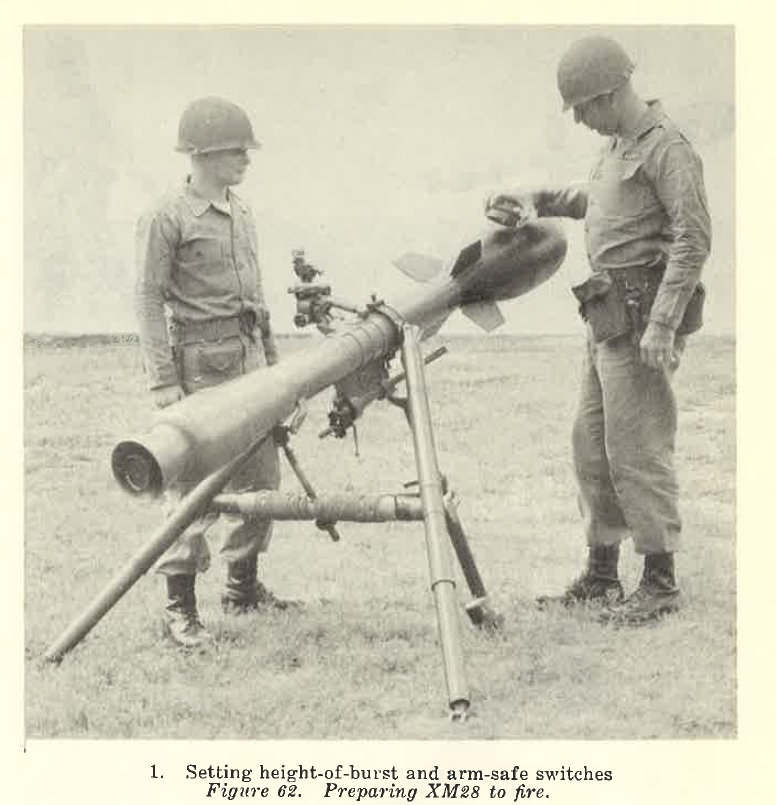
FIGURE 62-1. Setting height of burst and arm safe switches.
(3) The computer repeats the ammunition, height of burst, and the temperature correction factor.
(4) The assistant gunner repeats the ammunition and height of-burst commands and using the spanner wrench, sets the height-of-burst switch and arm-safe switch (1, fig.62). He closes the breech of the spotting rifle, removes the LEDC and places it on the ground, and the;1 assists the gunner as directed.
(5) The computer issues a new elevation.
(6) The gunner repeats new elevation and applies it to the sight. He relays on the target and cross-levels bubbles. He checks the height-of-burst switch, the arm-safe switch, and announces ARM-HI. He then unrolls the LEDC (2, fig. 62) its complete length, checks the back blast area, removes the safety wire, and announces UP.
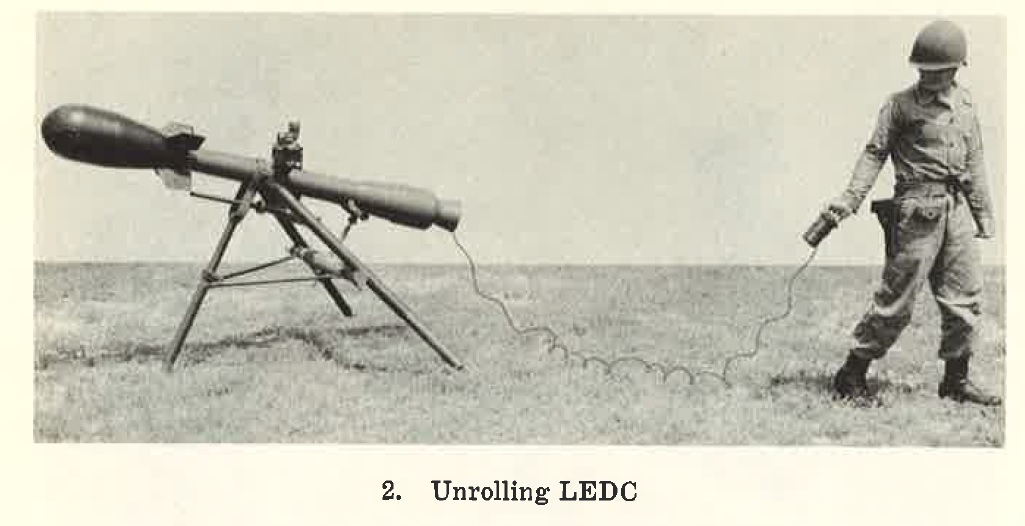
FIGURE 62-2.

FIGURE 62-3.
(7) The gunner fires as directed by squad leader. Note. If the timer dial setting must be changed after firing spotting ammunition, clear the spotting rifle and remove 279-mm projectile from weapon. Make new timer dial setting, reload, relay, and fire.
d. Projectile, Atomic, Super caliber, 279-mm, XM388. The procedure for firing the nuclear projectile is the same as for dummy XM421, c above, with the following exception-squad leader commands NUCLEAR in lieu of DUMMY.
e. Projectile, Atomic, Supercalibe1·, 279-mm, Practice, XM390. The procedure for firing practice projectile is the same as for dummy XM421, c above, with the following exceptions:
(1) Squad leader commands PRACTICE in lieu of DUMMY.
(2) Assistant gunne1· removes safety wire. Note. XM390 does not contain timer dial, arm-safe switch, or height-of-burst switch.
f. Going Out of Action.
(1) Squad leader commands END OF MISSION, OUT OF ACTION.
(2) Computer repeats END OF MISSION, OUT OF ACTION.
(3) Gunner replaces the safety wire, wraps the LEDC three times around the spool, and announces SAFE. He continues winding the LEDC, places it into the propellant container, and removes the sight.
(4) Assistant gunner and loader move the packs near the weapon position. The assistant gunner opens the breech of the spotting rifle, moves the arm-safe switch to safe position, and the HOB switch to LO position.
(5) Squad leader checks the switches and announces SAFELO.
(6) Assistant gunner and loade1· detach the round from the piston, placing it on the ground. Using the spanner wrench, assistant gunner moves the timer dial clockwise to the SAFE position.
(7) Squad leader checks the timer dial setting and announces SAFE.
(8) Assistant gunner returns the 279-mm projectile to the pack.
(9) Loader removes the piston.
(10) Gunner unlocks elevating tube, raises the chamber of the weapon, and pushes out on the propellant.
(11) Assistant gunner removes the propellant and returns it to the pack.
(12) Loader pulls out on the quick-release pins, unlocking the barrel from the tripod.
(13) Gunner removes the weapon and returns it to the pack.
(14) Loader and assistant gunne1· disassemble the tripod.
(15) Squad leader commands SECURE EQUIPMENT. All crew members replace their equipment on the packs and secure the straps.
g. indirect Fire.
(1) Form for crew drill, paragraph 107a(l).
(2) Ground equipment, paragraph I07a(2).
(3) Count off, paragraph 107a(3).
(4) Examine equipment, paragraph 107b.
(5) Reporting, paragraph 107c.
(6) The squad leader moves to a position six steps to the right flank and issues indirect fire command. Example: FIRE MISSION, GUN TO BE MOUNTED HERE (points), AZIMUTH ______ __ , COORDINATES_ ACTION.
(7) Squad members repeat elements of the fire command as follows:
(a) FIRE MISSION-computer.
(b) GUN TO BE MOUNTED HERE-loader (points).
(c) AZIMUTH _____ -computer.
(d) COORDINATES _ ______ -computer.
(e) ACTION-computer.
(8) Weapon is mounted as in b(3) through (8) above.
(9) The gunner mounts the sight, making sure it is firmly seated, places 3,200 mils on the azimuth scale, and O on the azimuth micrometer scale. He then moves approximately 25 meters from the weapon and removes his compass.
(10) The computer determines the position of the weapon on the map, plots the location of the target, determines mounting azimuth to nearest 50 mils, and announces azimuth to the gunner.
(11) The gunner repeats the azimuth and, using compass, points in the general direction of the target.
(12) The assistant gunner and loader pick up the weapon and turn it until the muzzle is pointing in the general direction of fire as established by the gunner.
(13) The gunner, with commanded azimuth on compass, alines the direction stake ( cleaning staff held by assistant gunner) with center of eyepiece of sight unit, by shooting azimuth through eyepiece to direction stake.
(14) The loader assembles the aiming posts and moves 100 meters to the right flank of the weapon, dropping one post en route 50 meters from the weapon. He drives in the aiming post and remains at that position.
(15) The gunner moves to the weapon and, using elevation and traversing mechanism, lays on direction stake; then motions for assistant gunner to return.
(16) The assistant gunner moves the major caliber projectile to the weapon position.
(17) The gunner lays the sight on the far aiming post and directs loader to correct for cant. He slips the deflection scale until he has a deflection reading of 3,200 mils. He directs the loader to place the near aiming post, then announces WEAPON LAID.
(18) The computer determines and announces DEFLECTION __ __ __ __ , ELEVATION _____ , and time dial setting TIME ------·
(19) The gunner repeats deflection and elevation and places them on sight. He determines position of front leg (par. 54).
(20) The weapon is loaded as in paragraph 17b.
(21) The weapon is laid for direction as in paragraph 95 except as follows-change target to read aiming post.
(22) The weapon is fired as in paragraph 99c (2).
h. Projectile, Atomic, Super caliber, 279-mm, Dummy, XM421. When fire has been adjusted on target using spotting ammunition, to simulate firing the nuclear projectile, procedure is as follows:
(1) The squad leader issues a subsequent fire command, DUMMY, HI (LO), RIGHT (LEFT) -- -- -- -- , ADD (DROP) ------·
(2) The computer repeats the deflection, elevation, ammunition, and height of burst. He computes and announces the new deflection and elevation setting.
(3) The assistant gunner repeats commands and sets switches as in paragraph 17b.

FIGURE 63. Forward for crew drill mounted.

FIGURE 64. "On vehicle" positions.
(4) The gunner repeats the new deflection and elevation, applies it to the sight, relays on aiming posts with bubbles level, checks height-of-burst and arm-safe switches and announces ARM-HI. He unrolls LEDC its complete length, removes safety wire, and announces UP.
(5) Gunner fires as directed by squad leader.
i. Projectile, Atomic, Super caliber, 279-mm, XM388. The procedure for firing the nuclear projectile is the same as for dummy XM421, paragraph 17b, with the following exception-squad leader commands NUCLEAR in lieu of DUMMY.
j. Projectile, Atomic, Super caliber, 279-mm, Practice, XM390. The procedure for firing practice projectile is the same as for dummy XM421, paragraph 17b, with the following exceptions:
(1) Squad leader commands PRACTICE in lieu of DUMMY.
(2) Assistant gunner removes safety wire.
k. Going Out of Action. Same as f above.
109. Placing the Light Weapon into Action on ¼-Ton Truck M38A1D Crew drill is conducted as follows when light weapon is mounted on ¼-ton carrier.
a. Forming for Crew Drill.
(1) At the command FORM FOR CREW DRILL, members of the squad form in one rank two steps forward of the weapon carrier. The squad leader takes position six steps forward and centered on the squad.
(2) Count off as in paragraph 107a(3).
b. Posting the Squad. At the command POST, the squad members face about and assume "on vehicle" positions (fig. 64).
c. Examine Equipment. Same as paragraph 107b with the following exceptions :
(1) Squad leader moves a short distance from vehicle to check compass.
(2) Gunner-
(a) Unlocks barrel travel lock and checks for serviceability.
(b) Checks vehicle mount for proper operation.
(c) Moves a short distance from vehicle to check compass.
(3) Assistant gunner checks to insure all ammunition components on weapon carrier are of correct type and serviceable.
(4) Loader checks to insure all ammunition components on ammunition vehicle are of correct type and serviceable.
d. Reporting. Same as paragraph 107c.
e. Fire Role. The weapon on carrier may be placed into action in either a direct or indirect fire role. The procedures are the same as in paragraph 108 except as indicated below:
(1) Gunner unlocks barrel travel lock, dismounts, secures and mounts sight, then same as paragraph 108.
(2) Assistant gunner dismounts, secures and loads propellant, then same as paragraph 108.
(3) Loader moves ammunition vehicle to safe position, returns to weapon carrier and loads launching piston, then: same as paragraph 10.
(4) Computer remains with ammunition vehicle, then s~me as paragraph 108.
Note. As of August 1961, clearance to fire XM28 from ¼-ton carrier has not been granted pending completion of firing tests.
f. Going Out of Action. Same as paragraph 108/ except as indicated below:
(1) Gunner places sight unit in case, locks barrel travel lock, mounts vehicle.
(2) Assistant gunner places projectile and propellant in containers, mounts vehicle.
(3) Loader places launching piston in container, secures and loads aiming posts, moves ammunition vehicle to weapon position.
<1-- ---------------------------------------------- SECTION III ------------------------------------- --> SECTION Ill. HEAVY WEAPON SYSTEM XM29 (5-MAN SQUAD)
110. General
a. In the infantry battle group, the XM29 heavy weapon is stowed in the Ml13 armored full-tracked personnel carrier. When stowed, it may be fired only from the ground mount. In the airborne battle group, the weapon is mounted on a l/4.-ton utility truck, M38AlD, and may be fired from either the carrier or the ground mount.
b. Projectile, atomic super caliber, 279-mm, practice, XM390 is used with the heavy weapon to adjust fire. To fire the XM390, remove the safety wire. Note. The XM390 does not contain a timer dial, HOB switch, or arm-safe switch.
111. Placing Weapon into Action from carrier, Ml 13, to Ground Mount
a. Forming for Crew Drill. The squad leader dismounts from the vehicle and moves to its left rear. After checking to insure the area to the immediate rear of the vehicle is free of personnel and equipment, he announces CLEAR. On the command CLEAR, the loader (driver) drops the ramp. The squad leader commands FORM FOR CREW DRILL. The loader exits from the top of the carrier; the remainder of the crew exits from the rear. The squad forms in front of the vehicle as in paragraph 107 a (1).
b. Count off. Same as paragraph 107a(3).
c. Posting the Squad. Same as paragraph 109b.
d. Examining Equipment. Squad leader commands EXAMINE EQUIPMENT BEFORE FIRING. At this command, crew members, with the exception of squad leader, mount the vehicle with the computer entering first and examine equipment as follows:
(1) Squad leader.
(a) Checks binoculars for broken parts.
(b) Checks radio for proper operation.
(c) Checks maps to see they cover the area.
(d) Moves short distance away from vehicle to check compass.
(2) Gunner (No.1).
(a) Removes nozzle and muzzle covers and checks barrel for cleanliness.
(b) Checks traversing and elevating mechanism for proper operation.
(c) Checks sight unit for operation and broken parts.
(3) Assistant gunner (No. 2).
(a) Checks tripod for operation.
(b) Checks major caliber ammunition for serviceability.
(4) Loader (No. 3).
(a) Checks propellants and piston launchers for serviceability.
(b) Checks aiming posts for serviceability.
(5) Computer (No. 4).
(a) Checks plotting board, protractor, and firing tables for serviceability.
(b) Checks maps to see they cover area.
(c) Checks radio for proper operation.
e. Reporting.
(1) Loader. Reports AMMUNITION CORRECT.
(2) Assistant gunner. Reports AMMUNITION AND MOUNT CORRECT.
(3) Gunner. Reports GUN CORRECT.
(4) Computer. Reports ALL CORRECT.
f. Placing Weapon into Action for Direct Fire Mission.
(1) Fire command-(issued by squad leader).
(a) FIRE MISSION-repeated by computer.
(b) GUN TO BE MOUNTED HERE-repeated by assistant gunner.
(c) ZONE-repeated by assistant gunner.
(d) AMMUNITION-repeated by assistant gunner and computer.
(e) DIRECTION-repeated by gunner.
(f) TARGET DESCRIPTION-repeated by gunner.
(g) RANGE-repeated by gunner and computer.
(h) ACTION.
(2) On the command ACTION, the assistant gunner moves the tripod to the position designated by the squad leader and unfolds it.
(3) The squad leader, gunner, and loader remove the weapon from the carrier and place it on the tripod.
(4) The gunner locks the carriage to the tripod.
(5) The assistant gunner loads the propellant, checking to be sure it is the right zone and has not been damaged.
(6) The loader, assisted by the assistant gunner, loads the launching piston, making sure to check the position of the obturator rings and the condition of the rubber gasket.
(7) The gunner attaches the sight and checks for correct seating.

FIGURE 65-1.
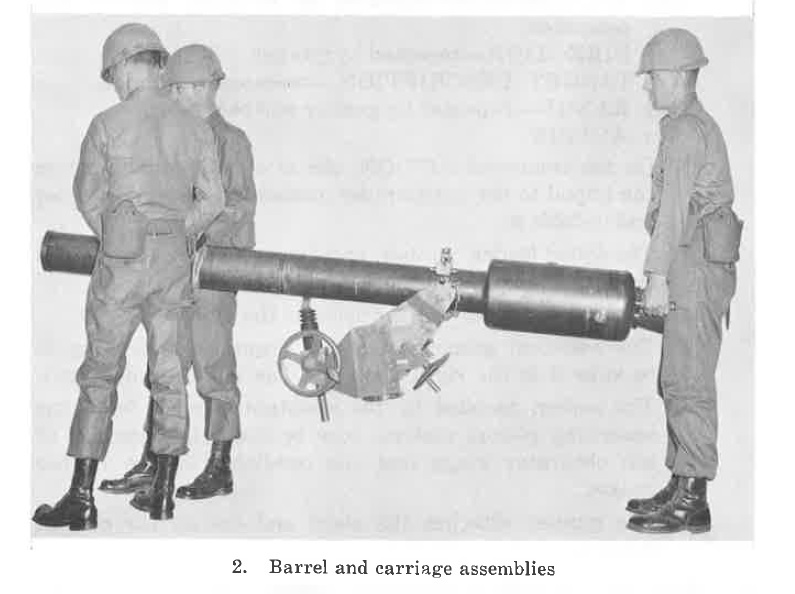
FIGURE 65-2. (continue)

FIGURE 65-3. (continue)
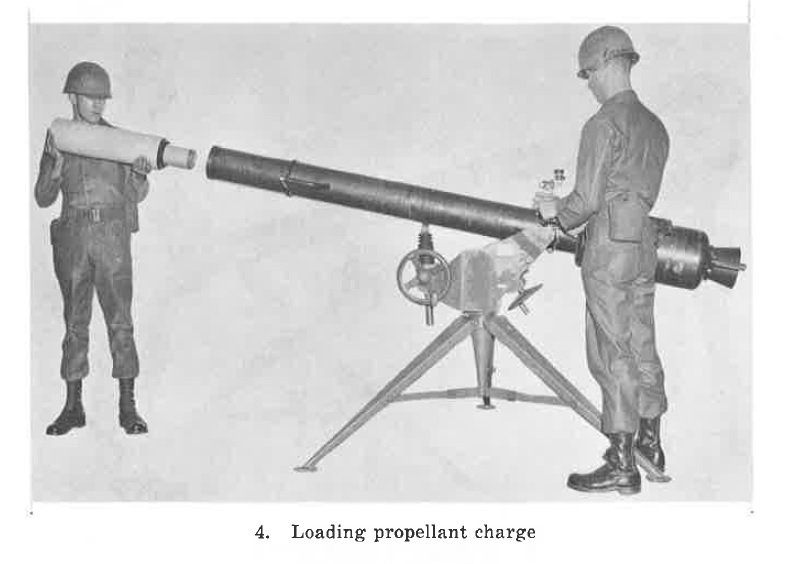
FIGURE 65-4. (continue)
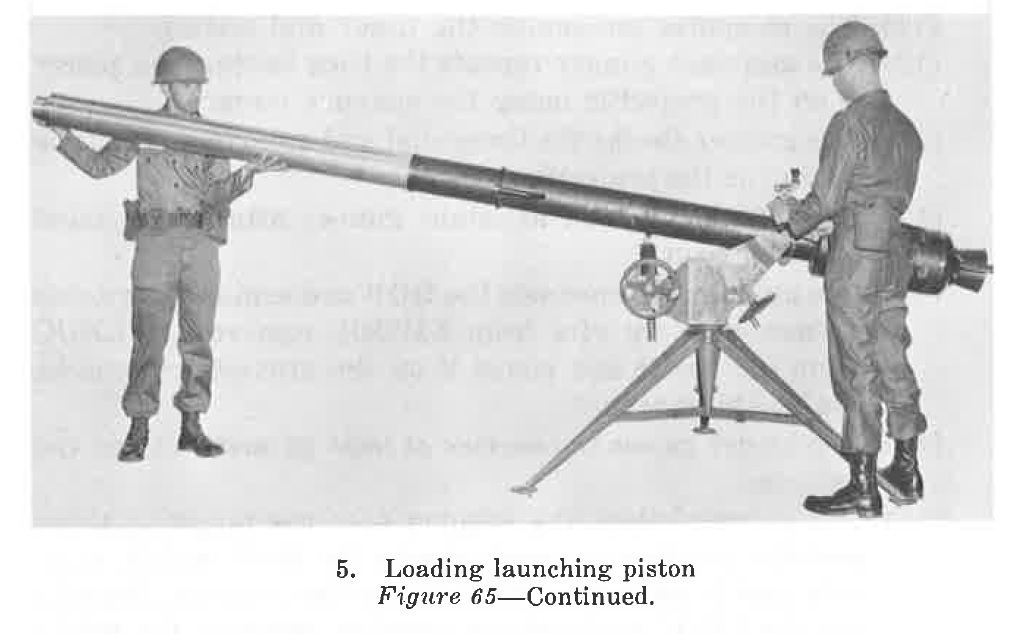
FIGURE 65-5. (continue)
(8) The gunner measures the angle-of-site to the target and announces it to the computer who repeats it.
(9) The computer takes the angle-of-site, computes an elevation, and announces it to the gunner.
(10) The gunner repeats the elevation and applies the elevation on the sight, but he does not lay the weapon on the target.
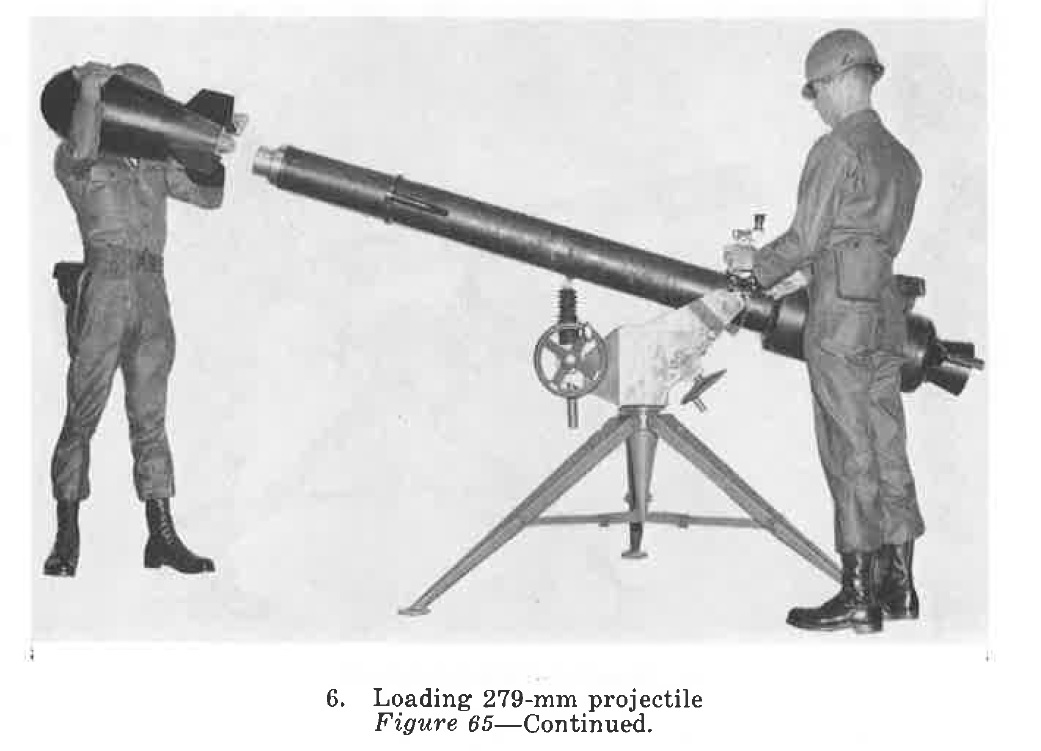
FIGURE 65-6. (continue)
(11) The computer announces the timer dial setting.
(12) The assistant gunner repeats the time setting and places it on the projectile using the spanner wrench.
(13) The gunner checks the timer dial and announces the time setting on the projectile.
(14) Both the loader and assistant gunner attach the round to the weapon.
(15) The assistant gunner sets the HOB and arm-safe switches (removes safety wire from XM390), removes the LEDC from the nozzle and places it on the ground, and checks the back blast area.
(16) The loader moves the carrier at least 25 meters from the weapon.
(17) The gunner relays the weapon onto the target, making sure the bubbles are level, checks the HOB switch, arm safe switch settings, and announces the settings. He rolls out the LEDC to the firing position, removes the safety wire, and announces UP. He fires on command.
g. Taking Weapon Out of Action from Direct Fire Mission.
(1) The squad leader announces END OF MISSION-OUT OF ACTION. These commands are repeated by the computer.
(2) The gunner replaces the safety wire, makes at least three wraps around the spool with the LEDC, and announces.
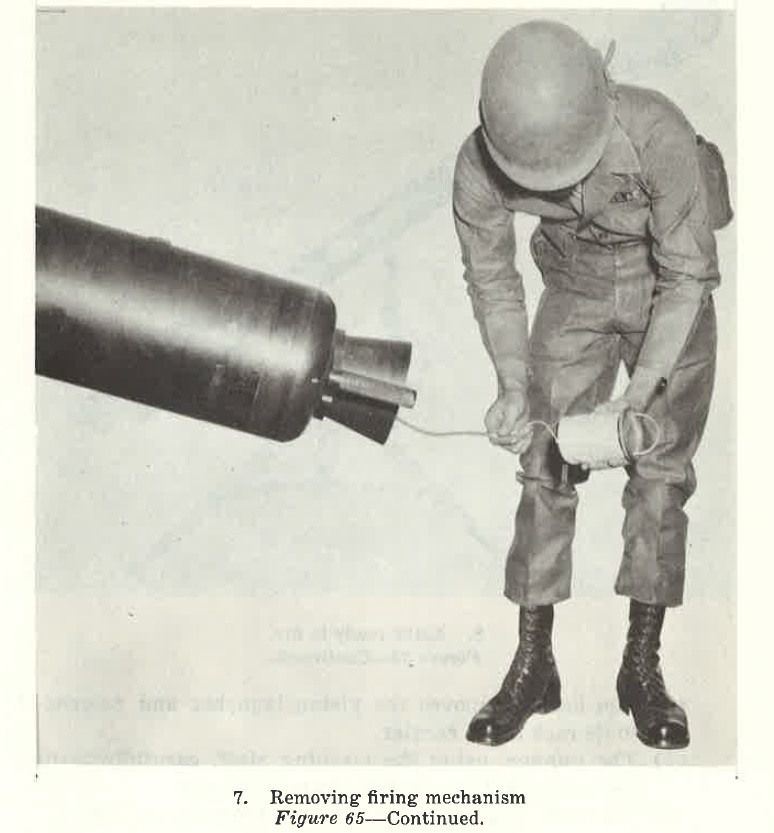
FIGURE 65-7. Removing firing mechanism. (continue)
SAFE. He continues to wind the LEDC. He removes the sight and returns it to the case.
(3) After the gunner announces SAFE, the loader returns the carrier to a position near the weapon.
(4) The assistant gunner returns to the weapon, depresses the elevating mechanism to its lowest position, returns the ARM-SAFE switch to SAFE, and the HOB switch to LO position. The squad leader checks this and announces SAFE. The leader and assistant gunner detach the projectile from the weapon and the assistant gunner returns the timer dial to the SAFE position. The squad leader checks the timer dial and announces SAFE.
(5) The assistant gunner returns the projectile to the carrier.
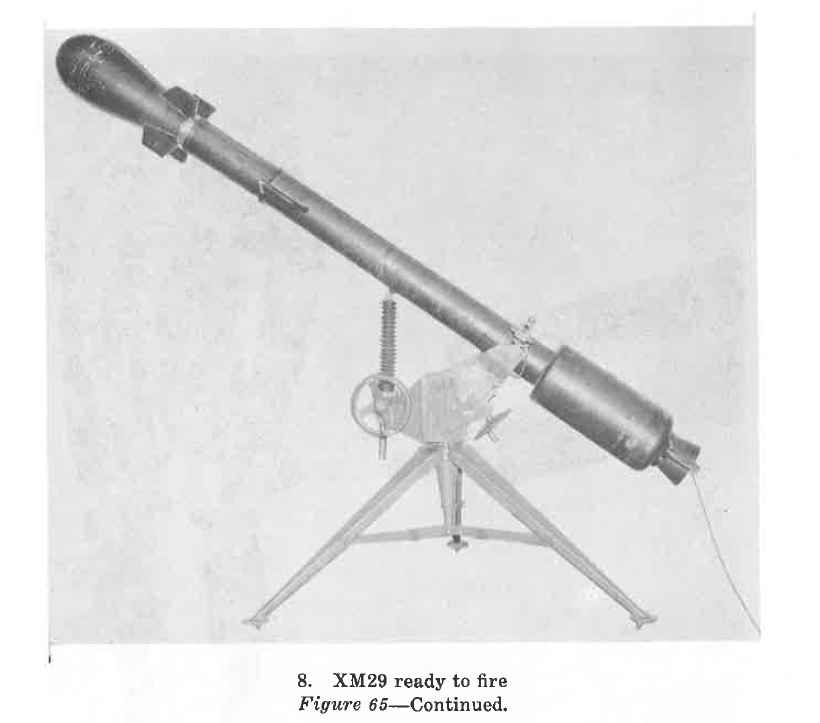
FIGURE 65-8. XM29 ready to fire. (continue)
(6) The loader removes the piston launcher and returns it to its rack in the carrier.
(7) The gunner, using the cleaning staff, carefully pushes the propellant out to the assistant gunner.
(8) The gunner unlocks the carriage from the tripod.
(9) The squad leader, gunner, and loader remove the weapon from the tripod and return it to the carrier.
(10) The assistant gunner folds and loads the tripod.
(11) The squad leader returns to his position in the carrier and the ramp is raised.
h. Placing the Weapon into Action for Indirect Fire Mission.
(1) Fire command-(issued by squad leader).
(a) FIRE MISSION-repeated by computer.
(b) AZIMUTH-repeated by computer.
(c) COORDINATES-repeated by computer.
(d) TARGET DESCRIPTION-repeated by gunner.
(e) AMMUNITION-repeated by assistant gunner and computer.
(f) ACTION.
(2) On the command ACTION, the assistant gunner takes the tripod to the position designated by the squad leader and then unfolds it.
(3) The squad leader, gunner, and loader remove the weapon from the carrier and place it on the tripod.
(4) The gunner locks the weapon to the tripod.
(5) The gunner attaches the sight to the weapon and checks for correct seating.
(6) Assistant gunner loads the propellant, checking to see that it is the correct zone and has not been damaged.
(7) The loader and the assistant gunner load the piston launcher.
(8) The gunner moves 25 meters to the rear of the weapon and removes his compass.
(9) The assistant gunner carries a direction stake and moves 25 meters to the front of the weapon.
(10) The loader assembles two aiming posts and moves 100 meters to the right of the weapon and drives in one post.
(11) The gunner sights through the sight on the weapon with his compass and moves the assistant gunner onto that line by use of arm signals.
(12) The gunner then moves to the weapon, traverses it onto the direction stake, and motions for the assistant gunner to return to the weapon. He traverses his sight onto the aiming post placed out by the loader. The gunner motions for the leader to come in 50 meters and place in the second aiming post. He then refers the deflection scale to 3,200 and his deflection micrometer scale to O and announces WEAPON LAID.
(13) The computer issues a deflection and an elevation. The gunner repeats the command and places them on the sight.
(14) The computer issues a timer dial setting. The assistant gunner repeats it and places the setting on the projectile.
(15) The gunner checks the timer dial and announces the time setting.
(16) The assistant gunner and loader attach the round to the weapon.
(17) The assistant gunner sets the ARM-SAFE switch and the HI-LO switch, removes the LEDC from the nozzle, and places it on the ground.
(18) The loader moves the carrier at least 25 meters from the weapon.
(19) The gunner relays on the aiming posts with bubbles level, checks his switches, and announces the switch settings. He rolls out the LEDC, removes the safety wire, and announces UP. He fires on command.
i. Taking the Weapon Out of Action from Indirect Fire Mission.
(1) The squad leader announces END OF MISSION, OUT OF ACTION.
(2) The procedures are the same as direct fire, g above, except when the gunner announces SAFE. The loader then returns the carrier to a position near the weapon and then moves out rapidly to the flank and retrieves the aiming posts.
112. Placing Weapon into Action on Carrier, ¼-Ton, M38A 1 D
a. Forming for Crew Drill. On the command FORM FOR CREW DRILL, the crew dismounts from its vehicles and forms two steps in front of and centered on the weapons carrier. The squad leader positions himself six steps from and centered on his squad.
b. Countofj. Same as paragraph 107a(3).
c. Examining Equipment. Same as paragraph llld.
d. Reporting. Same as paragraph llle.
e. Placing Weapon into Action for Direct Fire Mission.
(1) Fire command- (issued by squad leader).
(a) FIRE MISSION-repeated by computer.
(b) DIRECTION-repeated by gunner.
(c) TARGET DESCRIPTION-repeated by gunner.
(d) RANGE-repeated by gunner and computer.
(e) ZONE-repeated by assistant gunner.
(f) AMMUNITION-repeated by assistant gunner and computer.
(g) ACTION.
(2) On the command ACTION, the gunner attaches his sight to the weapon and checks for correct seating. He swings the weapon around until it is pointed in the general direction of the target.
(3) The assistant gunner loads the propellant, checking it for correct zone and for damage.
(4) The loader, assisted by the assistant gunner, loads the piston launcher, making sure the obturator rings are staggered and the rubber gasket is serviceable.
(5) The gunner measures the angle-of-site to the target and announces it to the computer who repeats it.
(6) The computer computes the elevation and announces it to the gunner.
(7) The gunner repeats the elevation and applies it to the sight, but does not lay the weapon on the target.
(8) The computer announces the time setting.
(9) The assistant gunner repeats the time setting and places it on the projectile.
(10) The gunner checks the timer dial and announces the time setting.
(11) Both the loader and assistant gunner attach the round to the weapon.
(12) The assistant gunner arms the switches, removes the LEDC from the nozzle, and places it on the ground. He then checks the back blast area.
(13) The gunner relays the weapon onto the target, making sure the bubbles are level, checks the HI-LO switch and the ARM-SAFE switch, and announces the switch settings. He then rolls out the LEDC to the firing position, removes the safety wire, and announces UP. He fires on command.
F, Taking the Weapon Out of Action from Direct Fire Mission.
(1) The squad leader announces END OF MISSION, OUT OF ACTION, and these commands are repeated by the computer.
(2) The gunner replaces the safety wire into the firing mechanism, makes at least three wraps around the spool with the LEDC, and announces SAFE. He then continues to wind the spool and replaces it into the nozzle of the weapon.
(3) After the gunner announces SAFE, the assistant gunner depresses the elevating mechanism to its lowest position and disarms the switches. Then, assisted by the loader, he removes the projectile after the squad leader checks the switches. The assistant gunner returns the timer dial switch to the SAFE position. The squad leader checks the timer dial and announces SAFE.
(4) The assistant gunner returns the projectile to the vehicle.
(5) The loader removes the piston launcher and the propellant.
(6) The gunner removes the sight and locks the barrel in place.
(7) The crew mounts its vehicles.
g. Placing Weapon into Action for Indirect Fire Mission.
(1) Fire command-(issued by squad leader).
(a) FIRE MISSION-repeated by computer.
(b) AZIMUTH-repeated by computer.
(c) COORDINATES-repeated by computer.
(d) AMMUNITION-repeated by assistant gunner and computer.
(e) ACTION.
(2) On the command ACTION, the gunner traverses the weapon to the general direction of fire.
(3) The computer announces azimuth and zone.
(4) The gunner attaches the sight to the weapon and checks for correct seating.
(5) Assistant gunner loads the propellant and checks it for correct zone and for possible damage.
(6) The loader and assistant gunner load the piston launcher.
(7) The gunner moves 25 meters to the rear of the weapon.
(8) The assistant gunner carries a direction stake and moves out 25 meters to the front of the weapon.
(9) The loader assembles two aiming posts, moves out 100 meters to the right of the weapon, and drives in one post.
(10) The gunner sights through the sight on the weapon with his compass and moves the assistant gunner onto that line by the use of arm signals. ·
(11) The gunner moves to the weapon, traverses it onto the direction stake, and motions for the assistant gunner to return to the weapon. He traverses his sight onto the far aiming post placed out by the loader. The gunner corrects the cant of the post, motions for the loader to come in 50 meters, and directs him to place out his second aiming post. He refers his black scale on the sight to 3,200 and the micrometer scale to 0, and announces WEAPON LAID.
(12) The computer issues a deflection and an elevation. The gunner repeats the commands and places them on his sight.
(13) The computer issues a timer dial setting. The assistant gunner repeats it and places it on the projectile.
(14) The gunner checks the timer dial and announces the time setting.
(15) The assistant gunner and loader attach the round to the weapon.
(16) The assistant gunner sets the ARM-SAFE switch and the HI-LO switch, removes the LEDC from the nozzle of the weapon, and places it on the ground. He checks the back blast area.
(17) The gunner relays onto the aiming posts with bubbles level, checks his switches, and announces the switch settings. He rolls out the LEDC to the firing position, removes the safety wire, and announces UP. He fires on command.
h. Taking the Weapon Out of Action from Indirect Fire Mission.
(1) The squad leader announces END OF MISSION, OUT OF ACTION, and this is repeated by the computer.
(2) The procedures are the same as direct fire in f above, except when the gunner announces SAFE, the loader moves out rapidly to the flank and retrieves the aiming posts.
113. Placing the Weapon into Action from Carrier, ¼-Ton, M38A 1 D, to Ground Mount
a. Forming for Crew Drill. Same as paragraph 107a(l).
b. Counto[f. Same as paragraph 107a(3).
c. Posting the Squad. Same as paragraph 109b.
d. Examining Equipment. Same as paragraph llld.
e. Reporting. Same as paragraph llle.
f. Placing the Weapon into Action for Direct Fire Mission. Same as paragraph lllf, except the assistant gunner moves the carrier at least 25 meters from the weapon prior to firing.
g. Taking the Weapon Out of Action from Direct Fire Mission. Same as paragraph lllg, except the assistant gunner returns the weapon carrier to a position near the weapon.
h. Placing the Weapon into Action for Indirect Fire Mission. Same as paragraph lllh, except the assistant gunner moves the weapon carrier at least 25 meters from the weapon prior to firing.
i. Taking the Weapon Out of Action from Indirect Fire Mission. Same as paragraph lllg, except the assistant gunner returns the weapon carrier to a position near the weapon and when the gunner announces SAFE, the loader moves out rapidly to the flank and retrieves the aiming posts.
SECTION IV. LIGHT WEAPON SYSTEM, XM28 (3-MAN SQUAD)
114. Placing the Light Weapon into Action on ¼-Ton Truck, M38A1D
a. General. The weapon may be placed into action in either a direct or indirect fire role. The fire command issued by the squad leader indicates the method of employment. Crew drill includes laying for direction, loading, and fire adjustment.
b. Forming for Crew Drill.
(1) At the command FORM FOR CREW DRILL, members of the squad form in one rank two paces forward of the weapons carrier. The squad leader takes position six steps forward and centered on the squad.
(2) Count off same as paragraph 107a(3).
c. Posting the Squad. At the command POST, the squad members face about and assume "on vehicle" positions.
d. Examining Equipment. Equipment is normally examined one time during each crew drill period. The squad leader commands EXAMINE EQUIPMENT BEFORE FIRING. Squad members examine equipment as follows:
(1) Squad leader.
(a) Checks binoculars for proper operation.
(b) Checks map to insure coverage of area.
(c) Checks compass for proper operation.
(d) Checks to insure correct firing tables.
(2) Gunner.
(a) Checks barrel and chamber of weapon to insure they are free of foreign objects and in serviceable condition.
(b) Checks barrel and chamber of spotting rifle (XM69) to insure they are free of foreign objects, that firing mechanism, breech, and extractor are operational, and that spotting rifle is secure in its mount.
(c) Checks fine elevation and traversing mechanisms for proper operation.
(d) Checks sight unit for proper operation.
(e) Checks compass for proper operation.
(3) Assistant gunner.
(a) Checks to insure there is no damage to the outside of nuclear projectile.
(b) Checks timer dial to see it is set on SAFE (S) position.
(c) Insures arm-safe switch is set on SAFE position.
(d) Insures height-of-burst switch is set on LO position.
(e) Insures dimple motors do not protrude from recesses.
(f) Checks tripod and launching piston for proper operation.
(g) Checks propellant charge and aiming posts for serviceability.
(h) Checks thermometer for proper operation.
e. Reporting. When all equipment is examined, the following reports are given:
(1) The assistant gunner reports MOUNT AND AMMUNITION CORRECT.
(2) The gunner reports GUN CORRECT.
f. Direct Fire.
(1) The squad leader moves to a position six steps to right flank of squad and issues a direct fire command. Example: FIRE MISSION, FRONT, TROOPS, ONE FIVE HUNDRED, ACTION.
(2) Gunner repeats elements of the fire command as follows:
(a) FIRE MISSION.
(b) FRONT.
(c) TROOPS.
(d) ONE FIVE HUNDRED.
(e) ACTION.
(3) Gunner unlocks barrel travel lock, dismounts, secures and mounts sight.
(4) The assistant gunner moves the thermometer from the propellant and announces the temperature reading to the computer. TEMPERATURE PLUS (MINUS) He loads the propellant.
(5) The squad leader repeats the temperature reading and records it.
(6) The gunner attaches the sight making sure it is firmly seated, places 3,200 mils on the azimuth scale and O on the azimuth micrometer scale, and lays on the target.
(7) The assistant gunner moves the piston to the weapons position and allows the gunner to inspect the obturator rings and rubber gasket, making sure the openings in the rings are separated 180°. He then loads the piston into the weapon, making sure the index tabs on the piston properly engage the key way slots on the barrel.
(8) The assistant gunner moves the 279-mm projectile to the weapon and removes the antenna dome cover.
(9) The gunner levels both bubbles and, by turning the angle of- site knob, places the horizontal cross line on the center mass of the target. He announces the angle of site as PLUS (MINUS) mils as indicated on the angle of-site scales.
(10) The squad leader repeats the angle of site and, using firing tables, computes and announces the elevation.
(11) The gunner repeats the elevation and applies it to the sight.
(12) The squad leader determines the fuze arming time and announces TIME,
(13) The gunner and assistant gunner repeat the fuze arming time.
(14) Using the spanner wrench, the assistant gunner places the fuze arming time on the timer dial by turning the dial clockwise.
(15) The gunner moves to the projectile, checks time setting, and announces TIME.
(16) The assistant gunner and gunner aline the bayonet pins with the bayonet slots, pushing the round well forward and turning it clockwise until it is firmly locked to the piston with no visible gap showing. (Do not use fins on projectile as hand grips when handling.)
(17) The assistant gunner loads the spotting rifle and announces READY. He then assists the gunner to relay on on the target.
(18) When the vertical cross line is centered on the target and both bubbles are leveled, the gunner announces UP.
(19) The squad leader commands FIRE.
(20) The assistant gunner fires the spotting rifle and immediately extracts the expended round. He checks the index tabs of the piston to see they are still engaged with the key way slots, and that the round is still firmly locked to the piston by observing the position of the fins in relation to the barrel of the spotting rifle.
g. Projectile, Atomic, Super caliber, 279-mm, Dummy, XM421.
(1) When fire has been adjusted on target using spotter ammunition, to simulate firing the nuclear projectile, procedure is as follows:
(a) The squad leader computes the new range, height of burst, and the temperature correction factor, and issues a subsequent fire command: DUMMY, HI (LO), ELEVATION.
(b) The gunner repeats the elevation, applies it to the sight, and relays on the target.
(c) The assistant gunner repeats the ammunition and height-of-burst command; and using the spanner wrench, sets the height-of-burst switch and arm-safe switch. He closes the breech of the spotting rifle, removes the LEDC and places it on the ground, and then assists the gunner as directed.
(d) The gunner cross-levels the bubbles, checks height of- burst switch and ARM-SAFE switch, and announces ARM-HI. He then unrolls the LEDC its complete length, checks back blast area, removes the safety wire, and announces UP.
(2) The gunner fires as directed by the squad leader. Note. If the timer dial setting must be changed after firing spotting ammunition, clear the spotting rifle and remove the 279- mm projectile from the weapon. Make new timer dial setting, reload, relay, and fire.
h. Projectile, Atomic, Super caliber, 279-mm, Practice, XM390. The procedures for firing the practice projectile are the same as for dummy round XM421, g above, with the following exceptions:
(1) The squad leader commands PRACTICE in lieu of DUMMY.
(2) The assistant gunner removes the safety wire. (XM390 does not have a timer dial, ARM-SAFE switch, or height of burst switch.)
i. Projectile, Atomic, Super caliber, 279-mm, XM388. The procedures for firing the nuclear projectile are the same as for dummy round XM421, g above, with the following exception-the squad leader commands NUCLEAR in lieu of DUMMY.
j. Going Out of Action.
(1) Squad leader commands END OF MISSION, OUT OF ACTION.
(2) Gunner repeats the command, replaces the safety wire, wraps the LEDC three times around the spool, and announces SAFE. He continues to wind the LEDC, places it into the propellant, and removes the sight.
(3) Assistant gunner opens the breech of the spotting rifle, moves the arm-safe switch to the SAFE position, and sets the HI-LO switch on the LO position.
(4) Squad leader checks the switches and announces SAFELO.
(5) Assistant gunner and gunner detach the round from the piston, placing it on the ground. Using the spanner wrench, the assistant gunner returns the timer dial to the safe position.
(6) Squad leader checks the timer dial and announces SAFE.
(7) Assistant gunner unloads the piston.
(8) Gunner raises the chamber and pushes out on the propellant.
(9) Assistant gunner unloads the propellant. Note. As of August 1961, clearance to fire XM28 from 1/4-ton carrier has not been granted pending completion of firing tests.
(10) Gunner places sight unit in case, locks barrel travel lock, and mounts vehicle.
(11) Assistant gunner secures and loads aiming posts.
k. Indirect Fire.
(1) Form for crew drill, paragraph 107a (1).
(2) Count off, paragraph 107a(3).
(3) Examine equipment, paragraph 107b.
(4) Reporting, paragraph 107c.
(5) The squad leader moves to a position six steps to the right flank and issues indirect fire command (par. 108g(6)).
(6) Squad members repeat elements of the fire command as in paragraph 108g (7).
(7) The gunner mounts the sight, making sure it is firmly seated, places 3,200 mils on the azimuth scale and O on the azimuth micrometer scale. He then moves approximately 25 meters from the weapon and removes his compass.
(8) The squad leader determines the position of the weapon on the map, plots the location of the target, determines mounting azimuth to nearest 50 mils, and announces azimuth to the gunner.
(9) The gunner repeats the azimuth and, using compass, points in the general direction of the target.
(10) The assistant gunner traverses the weapon until tht muzzle is pointing in the general direction of fire as established by the gunner.
(11) The gunner, with commanded azimuth on compass, alines the direction stake ( cleaning staff held by assistant gunner) with center of eyepiece of sight unit by shooting azimuth through eyepiece to direction stake.
(12) The gunner moves to the weapon and, using elevation and traversing mechanisms, lays on direction stake, and motions for assistant gunner to return.
(13) The assistant gunner assembles the aiming posts, moves 100 meters to the right flank of the weapon, and drops one post en route 50 meters from the weapon. He drives in aiming post and remains at that position.
(14) The gunner lays the sight on the far aiming post and directs assistant gunner to correct for cant. He slips the deflection scale until he has a deflection reading of 3,200 mils. He directs the assistant gunner to place the near aiming post, and then announces WEAPON LAID.
(15) The assistant gunner moves the major caliber projectile to the weapons position.
(16) The squad leader determines and announces DEFLECTION, ELEVATION, and timer dial setting TIME.
(17) The gunner repeats deflection and elevation, and places them on sight.
(18) The weapon is laid for direction as in paragraph 95, except-change target to read aiming post.
(19) The weapon is fired as in paragraph 99c(2).
115. Placing the Light Weapon into Action on Ground Mount from ¼-Ton Truck M38A1D
a. General. The weapon may be placed into action in either a direct or indirect fire role. The fire command issued by the squad leader indicates the method of employment. Crew drill includes mount, laying for direction, loading, and fire adjustment.
b. Forming for Crew Drill. Same as paragraph 114b.
c. Posting the Squad. Same as paragraph 114c.
d. Examine Equipment. Same as paragraph 114d.
e. Repo1·ting. Same as paragraph 114e.
f. Direct Fire.
(1) The squad leader moves to a position six steps to right flank of squad and issues a direct fire command. Example: FIRE MISSION, WEAPON TO BE MOUNTED HERE (points), FRONT, TROOPS, ONE FIVE HUNDRED, ACTION.
(2) Squad members repeat elements of the fire command as follows:
(a) FIRE MISSION.
(b) GUN TO BE MOUNTED HERE-assistant gunner (points).
(c) FRONT-gunner.
(d) TROOPS-gunner.
(e) ONE FIVE HUNDRED-gunner.
(f) ACTION.
(3) On the command ACTION, the assistant gunner (with tripod) moves to the position designated by the squad leader and places tripod on the ground with the rear legs pointing in the direction of fire. The gunner and assistant gunner extend the rear legs until the leg locking plunger snaps into position, attach the cross tube assembly, connect the struts, and set the tripod in an upright position. The assistant gunner checks the shoes on the rear legs to insure they are not canted, locks the front leg in its halfway position, positions the gimbal ring, and pulls out on the two quick-release pins. He then assists
(4) the gunner in attaching the barrel to the tripod. The gunner inserts the muzzle of the weapon into the gimbal ring, pushing it forward until the assistant gunner pushes in on the quic_k-release pins. The gunner inserts the elevating tube into the cross tube assembly and locks it in place.
(5) The assistant gunner removes the thermometer from the propellant and announces the temperature reading to the computer as TEMPERATURE PLUS (MINUS) -------· He loads the propellant into the weapon.
(6) The squad leader repeats the temperature reading and records it.
(7) The gunner attaches the sight, making sure it is firmly seated, places 3,200 mils on the azimuth scale and O on the micrometer scale, and lays on the target by directing the assistant gunner to move the tripod right or left.
(8) The assistant gunner moves the piston to the weapon position and allows the gunner to inspect the obturator rings and rubber gasket, making sure the openings in the rings are separated 180°. He then loads the piston into the weapon, making sure the index tabs on the piston properly engage the key way slots on the barrel.
(9) The assistant gunner moves the 279-mm projectile to the weapon and removes the antenna dome cover.
(10) The gunner levels both bubbles and, by turning the angle of-site knob, places the horizontal cross line on the center of mass of the target. He announces the angle of site as PLUS (MINUS) mils as indicated on the angle of-site scales.
(11) The squad leader repeats the angle of site and, using firing tables, computes and announces the elevation.
(12) The gunner repeats the elevation and applies it to the sight. (At this time the position of the front leg is determined (par. 54)).
(13) The squad leader determines the fuze arming time and announces TIME.
(14) The gunner and assistant gunner repeat the fuze arming time.
(15) Using the spanner wrench, the assistant gunner places the fuze arming time on the timer dial.
(16) The gunner moves to the projectile, checks time setting, and announces TIME.
(17) The assistant gunner and gunner aline the bayonet pins with the bayonet slots, pushing the round well forward and turning it clockwise until it is firmly locked to the piston with no visible gap showing. (Do not use fins of projectile as hand grips when handling.)
(18) The assistant gunner loads the spotting rifle and announces READY. He then assists the gunner to relay on the target by moving the coarse elevation and traversing mechanism as directed, and keeps the sight cross leveled.
(19) The gunner relays onto the target by using the small deflection and elevation knobs or by directing the assistant gunner to move the weapon right or left, up or down, steady-hold, until the vertical cross line is centered on the target and both bubbles are leveled. He then announces UP.
(20) The squad leader commands FIRE.
(21) The assistant gunner fires the spotting rifle and immediately extracts the expended round. He checks the index tabs of the piston to see they are still engaged with the key way slots, and that the round is still firmly locked to the piston by observing the position of the fins in relation to the barrel of the spotting rifle.
g. Projectile, Atomic, Super caliber, 279-mm, Dummy, XM421. When fire has been adjusted on target using spotter ammunition, to simulate firing the nuclear projectile, procedure is as follows:
(1) The squad leader computes the new range, height of burst, and the temperature correction factor and issues a subsequent fire command: DUMMY, HI (LO), ELEVATION.
(2) The assistant gunner repeats the ammunition and height of-burst command. Using the spanner wrench, he sets the height-of-burst switch and ARM-SAFE switch, closes the breech of the spotting rifle, removes the LEDC and places it on the ground, and then assists the gunner as directed.
(3) The gunner repeats the new elevation, applies it to the sight, and relays on the target; cross-levels the bubbles; checks height-of-burst switch and ARM-SAFE switch; and announces ARM-HI. He then unrolls the LEDC its complete length, checks back blast area, removes the safety wire, and announces UP.
(4) The gunner fires as directed by the squad leader. Note. If the timer dial setting must be changed after firing spotting ammunition, clear the spotting rifle and remove the 279- mm projectile from the weapon. Make new timer dial setting, reload, relay, and fire.
h. Projectile, Atomic, Supe1·calibe1·, 279-mm, Practice, XM390. The procedures for firing the practice projectiles are the same as for dummy round XM421, g above, with the following exceptions:
(1) The squad leader commands PRACTICE in lieu of DUMMY.
(2) The assistant gunner removes the safety wire. (XM390 does not have a timer dial, ARM-SAFE switch, or height of- burst switch.)
i. Projectile, Atomic, Super caliber, 279-mm, XM388. The procedures for firing the nuclear projectile are the same as for dummy round XM421, g above, except-the squad leader commands NUCLEAR in lieu of DUMMY.
j, Going Out of Action.
(1) Squad leader commands END OF MISSION, OUT OF ACTION.
(2) Gunner repeats command, replaces the safety wire, wraps the LEDC three times around the spool, and announces SAFE. He continues to wind the LEDC, places it into the propellant, and removes the sight.
(3) Assistant gunner opens the breech of the spotting rifle, moves the ARM-SAFE switch to the SAFE position and the HOB switch to the LO position.
(4) Squad leader checks the switches and announces SAFELO.
(5) Assistant gunner and gunner detach the round from the piston, placing it on the ground. Using the spanner wrench, the assistant gunner returns the timer dial to the SAFE position.
(6) Squad leader checks the timer dial and announces SAFE.
(7) Assistant gunner returns the 279-mm projectile to the vehicle and removes the piston.
(8) Gunner unlocks the elevating tube, raises the chamber, and pushes out on the propellant.
(9) Assistant gunner pulls out on the two locking pins, removes the propellant, and returns it to the vehicle.
(10) Gunner removes and returns the weapon to the vehicle.
(11) Assistant gunner disassembles and returns the tripod to the vehicle.
e. Indirect Fire.
(1) Form for crew drill, paragraph 114b.
(2) Count off, paragraph 114b.
(3) Examine equipment, paragraph 114d.
(4) Reporting, paragraph 114e.
(5) The squad leader moves to a position six steps to the right flank and issues indirect fire command.
Example: FIRE MISSION, GUN TO BE MOUNTED HERE (points), ACTION.
(6) Assistant gunner repeats elements of the fire command as follows:
(a) FIRE MISSION
(b) GUN TO BE MOUNTED HERE-(points).
(c) ACTION.
(7) Weapon is mounted as in paragraph 108g.
(8) The gunner mounts the sight, making sure it is firmly seated, places 3,200 mils on the azimuth scale, and O on the azimuth micrometer scale. He then moves approximately 25 meters from the weapon and removes his compass.
(9) The squad leader determines the position of the weapon on the map, plots the location of the target, determines mounting azimuth to nearest 50 mils, and announces azimuth to the gunner.
(10) The gunner repeats the azimuth and, using compass, points in the general direction of the target.
(11) The assistant gunner picks up the weapon, and turns it until the muzzle is pointing in the general direction of fire as established by the gunner.
(12) The gunner, with commanded azimuth on compass, aligns the direction stake (cleaning staff held by assistant gunner) with center of eyepiece of sight unit by shooting azimuth through eyepiece to direction stake.
(13) The gunner moves to the weapon and, using elevation and traversing mechanisms, lays on direction stake, then motions for assistant gunner to return.
(14) The assistant gunner assembles the aiming posts, moves 100 meters to the right flank of the weapon, and drops one post en route 50 meters from the weapon. He drives in aiming post and remains at that position.
(15) The gunner lays the sight on the far aiming post and directs assistant gunner to correct for cant. He slips the deflection scale until he has a deflection reading of 3,200 mils. He directs the assistant gunner to place out the near aiming post, then announces WEAPON LAID.
(16) The assistant gunner moves the major caliber projectile to the weapon position.
(17) The squad leader determines and announces DEFLECTION, ELEVATION, -- and timer dial setting TIME,
(18) The gunner repeats deflection and elevation and places them on sight. He determines position of front leg (par. 54).
(19) The weapon is loaded as in paragraph 99c (1).
(20) The weapon is laid for direction as in paragraph 95 except-change target to read aiming post.
(21) The weapon is fired as in paragraph 99c(2).
l. Projectile, Atomic, Super caliber, 279-mm, Dummy, XM421. When fire has been adjusted on target using spotter ammunition, to simulate firing the nuclear projectile, procedure is as follows:
(1) The squad leader computes the new range, deflection, height-of-burst, and temperature correction factor.
(2) The squad leader issues a subsequent fire command: DUMMY, HI (LO), DEFLECTION, ELEVATION.
(3) The assistant gunner repeats commands and sets switches as in paragraph 17b.
(4) The gunner repeats the new deflection and elevation, applies them to the sight, relays on aiming posts with bubbles level, checks height-of-burst and arm-safe switches, and announces ARM-HI. He unrolls LEDC its complete length, removes safety wire, and announces UP.
(5) Gunner fires as directed by squad leader.
m. Projectile, Atomic, Super caliber, 279-mm, XM388.
The procedure for firing the nuclear projectile is the same as for dummy XM421, l above, with the following exception-squad leader commands NUCLEAR in lieu of DUMMY.
n. Projectile, Atomic, SupercaUber, 279-mm, Practice, XM390.
The procedure for firing the practice projectile is the same as for dummy XM421, l above, with the following exceptions:
(1) Squad leader commands PRACTICE in lieu of DUMMY.
(2) Assistant gunner removes safety wire.
o. Going Out of Action. Same as j above.
SECTION V. HEAVY WEAPON SYSTEM, XM29 (3-MAN SQUAD)
116. Placing Weapon into Action from Carrier, M 113, to Ground Mount
a. Fo1lowing for Crew Drill. The squad leader dismounts from the vehicle and moves to its left rear. After checking to insure that the area to the immediate rear of the vehicle is free of personnel and equipment, announces CLEAR. On the command CLEAR, the assistant gunner (driver) drops the ramp. The squad leader commands FORM FOR CREW DRILL. The assistant gunners exits from the top of the carrier, the gunner exits from the rear. The squad forms in front of the vehicle as in paragraph 107 a (1).
b. Count off. Same as paragraph 107a(3).
c. Posting the Squad. Same as paragraph 109b.
d. Examining Equipment. Squad leader commands EXAMINE EQUIPMENT BEFORE FIRING. At this command, the crew members mount the vehicle, with the squad leader entering first, and examine equipment as follows :
(1) Squad leader.
(a) Checks binoculars for broken parts.
(b) Checks radio for proper operation.
(c) Checks maps to see they cover the area.
(d) Moves short distance away from vehicles to check operation of compass.
(e) Checks plotting board, protractor, and firing tables for serviceability.
(2) Gunner (No.1).
(a) Removes nozzle and muzzle covers and checks barrel for cleanliness.
(b) Checks traversing and elevating mechanism for proper operation.
(c) Checks sight unit for operation and broken parts.
(3) Assistant gunner (No. 2).
(a) Checks tripod for operation.
(b) Checks ammunition for serviceability.
(c) Checks propellants and piston launchers for serviceability.
(d) Checks aiming posts for serviceability.
e. Reporting.
(1) Assistant gunner. Reports AMMUNITION AND MOUNT CORRECT.
(2) Gunner. Reports GUN CORRECT.
f. Placing W capon into Action for Direct Fire Mission.
(1) Fire command-{issued by squad leader).
(a) FIRE MISSION-repeated by gunner.
(b) GUN TO BE MOUNTED HERE-repeated by assistant gunner.
(c) DIRECTION-repeated by gunner.
(d) TARGET DESCRIPTION-repeated by gunner.
(e) RANGE-repeated by gunner.
(f) ZONE-repeated by assistant gunner.
(g) AMMUNITION-repeated by assistant gunner.
(h) ACTION.
(2) On the command ACTION, the assistant gunner takes the tripod to the position designated by the squad leader and unfolds it.
(3) The squad leader, gunner, and assistant gunner remove the weapon from the carrier and place it on the tripod.
(4) The gunner locks the carriage to the tripod.
(5) The assistant gunner loads the propellant, checking to be sure it is the right zone and that it is not damaged.
(6) The assistant gunner loads the piston launcher, making sure to check the position of the obturator rings and the condition of the rubber gasket.
(7) The gunner attaches the sight and checks for correct seating.
(8) The gunner measures the angle of site to the target and announces it to the squad leader who repeats it.
(9) The squad leader takes the angle of site, computes an elevation, and announces it to the gunner.
(10) The gunner repeats the elevation and applies the elevation on the sight, but does not lay on the target.
(11) The squad leader announces the timer dial setting.
(12) The assistant gunner repeats the time setting and places it on the projectile, using the spanner wrench.
(13) The gunner checks the timer dial and announces the time setting on the projectile.
(14) The gunner and assistant gunner attach the round to the weapon.
(15) The assistant gunner sets the HOB and ARM-SAFE switches (removes safety wire from XM390), removes the LEDC from the nozzle, places it on the ground, and checks the back blast area.
(16) The assistant gunner moves the carrier at least 25 meters from the weapon.
(17) The gunner relays the weapon onto the target (making sure the bubbles are level), checks the HOB and ARMSAFE switch settings, and announces the settings. He rolls out the LEDC to the firing position, removes the safety wire, and announces lJP. He fires on command.
g. Taking Weapon out of Action from Direct Fire Mission.
(1) The squad leader announces END OF MISSION, OUT OF ACTION, and these commands are repeated by the gunner.
(2) The gunner replaces the safety wire, makes at least three wraps around the spool with the LEDC, and announces SAFE. He continues to wind the spool and re-tapes it to the propellant. He removes the sight and returns it to its case.
(3) After the gunner announces SAFE, the assistant gunner returns the carrier to a position near the weapon.
(4) The squad leader returns to the weapon, depresses the elevating mechanism to its lowest position, returns the ARM-SAFE switch to SA;FE, and the HI-LO switch to LO position. The assistant gunner detaches the projectile from the weapon and returns the timer dial to the SAFE position. The squad leader checks the timer dial and announces SAFE.
(5) The assistant gunner returns the projectile to the carrier.
(6) The squad leader removes the launching piston and returns it to its rack in the carrier.
(7) The gunner, using the cleaning staff, carefully pushes the propellant out to the assistant gunner.
(8) The gunner unlocks the carriage from the tripod.
(9) The squad leader, gunner, and assistant gunner remove the weapon from the tripod and return it to the carrier.
(10) The assistant gunner folds and loads the tripod.
(11) The squad leader returns to his position in the carrier and the ramp is raised.
h. Placing the Weapon into Action for Indirect Fire Mission.
(1) Fire command-( issued by squad leader).
(a) FIRE MISSION-repeated by gunner.
(b) DIRECTION OF FIRE-repeated by gunner.
(c) AMMUNITION-repeated by assistant gunner.
(d) ACTION.
(2) On the command ACTION, the assistant gunner takes the tripod to the position designated by the squad leader and then unfolds it.
(3) The squad leader, gunner, and assistant gunner remove the weapon from the carrier and place it on the tripod.
(4) The gunner locks the gun to the tripod.
(5) The gunner attaches the sight to the weapon and checks for correct seating.
(6) Assistant gunner loads the propellant, checking to see that it is the correct zone and that it is not damaged.
(7) The assistant gunner loads the piston launcher.
(8) The gunner moves 25 meters to the rear of the weapon and removes his compass.
(9) The assistant gunner carries a direction stake and moves 25 meters to the front of the weapon.
(10) The squad leader issues a mounting azimuth.
(11) The gunner sights through the sight on the weapon with his compass and moves the assistant gunner onto that line by the use of arm signals.
(12) The gunner then moves to the weapon and traverses it onto the direction stake, and motions for the assistant gunner to place out the aiming posts. The assistant gunner moves out 100 meters to the right of the weapon and drives one post. The gunner traverses his sight onto the aiming post placed out by the assistant gunner. The gunner motions for the assistant gunner to come in 50 meters and place in the second aiming post. He then refers the deflection scale to 3,200 and his deflection micrometer scale to O and announces WEAPON LAID.
(13) The squad leader issues a deflection and an elevation. The gunner repeats the command and places them on the sight.
(14) The squad leader issues a timer dial setting. The assistant gunner repeats it and places the setting on the projectile.
(15) The gunner checks the timer dial and announces the time setting.
(16) The assistant gunner and gunner attach the round to the weapon.
(17) The assistant gunner sets the ARM-SAFE switch and the HI-LO switch, removes the LEDC from the nozzle, and places it on the ground.
(18) The assistant gunner moves the carrier at least 25 meters from the weapon.
(19) The gunner relays on the aiming posts with bubbles level, checks his switches, and announces the switch settings. He rolls out the LEDC, removes the safety wire, and announces UP. He fires on command.
i. Taking the Weapon out of Action from Indirect Fire Mission.
(1) The squad leader announces END OF MISSION, OUT OF ACTION.
(2) The procedures are the same as direct fire (par. lllg), except when the gunner announces SAFE, the assistant gunner returns the carrier to a position near the weapon and then moves out rapidly to the flank and retrieves the aiming posts.
117. Placing Weapon into Action on Carrier, ¼-Ton, M38A1 D
a. Forming fire Crew Drill. On the command FORM FOR CREW DRILL, the crew dismounts from its vehicles and forms two steps in front of and centered on the weapon carrier. The squad leader positions himself six steps from and centered on the squad.
b. Count off. Same as paragraph 109a(3).
c. Post the Squad. Same as paragraph 109b.
d. Examining Equipment. Same as paragraph 116d.
e. Reporting. Same as paragraph 116e.
f. Placing Weapon into Action for Direct Fire Mission.
(1) Fire command-(issued by squad leader).
(a) FIRE MISSION-repeated by gunner.
(b) DIRECTION-repeated by gunner.
(c) TARGET DESCRIPTION-repeated by gunner.
(d) RANGE-repeated by gunner.
(e) ZONE-repeated by assistant gunner.
(f) AMMUNITION-repeated by assistant gunner.
(g) ACTION.
(2) On the command ACTION, the gunner attaches his sight to the weapon and checks for correct seating. He swings the weapon around until it is pointed in the general direction to the target.
(3) The assistant gunner loads the propellant, checking it for correct zone and for possible damage.
(4) The assistant gunner loads the piston launcher, making sure the obturator rings are staggered and the rubber gasket is serviceable.
(5) The gunner measures the angle of site to the target and announces it to the squad leader who repeats it.
(6) The squad leader computes the elevation and announces it to the gunner.
(7) The gunner repeats the elevation and applies it to the sight, but does not lay the weapon on the target.
(8) The squad leader announces the time setting.
(9) The assistant gunner repeats the time setting and places it on the projectile.
(10) The gunner checks the timer dial and announces the time setting.
(11) The gunner and assistant gunner attach the round to the weapon.
(12) The assistant gunner arms the switches, removes the LEDC from the nozzle, places it on the ground, and then checks the back blast area.
(13) The gunner relays the weapon onto the target (making sure the bubbles are level), checks the HI-LO switch and the ARM-SAFE switch, and announces the switch settings. He then rolls out the LEDC to the firing position, removes the safety wire, and announces UP. He fires on command.
g. Taking the Weapon out of Action from Direct Fire Mission.
(1) The squad leader announces END OF MISSION, OUT OF ACTION, and these commands are repeated by the gunner.
(2) The gunner replaces the safety wire into the firing mechanism, makes at least three wraps around the spool with the LEDC, and announces SAFE. He then continues to wind the spool and replaces it into the nozzle of the weapon.
(3) After the gunner announces SAFE, the squad leader depresses the elevating mechanism to its lowest position and disarms the switches. Then the assistant gunner removes the projectile. The assistant gunner returns the timer dial switch to the SAFE position. The squad leader checks the timer dial and announces SAFE.
(4) The assistant gunner returns the projectile to the vehicle.
(5) The squad leader removes the piston launcher.
(6) The assistant gunner removes the propellant.
(7) The gunner removes the sight, and locks the barrel in place.
(8) The crew 111ounts the weapon carrier.
h. Placing Weapon into Action for Indirect Fire Mission.
(1) Fire command-( issued by squad leader).
(a) FIRE MISSION-repeated by gunner.
(b) AMMUNITION-repeated by assistant gunner.
(c) ACTION.
(2) On the command ACTION, the gunner traverses the weapon to the general direction of fire.
(3) The squad leader announces azimuth and zone.
(4) The gunner attaches the sight to the weapon and checks for correct seating.
(5) Assistant gunner loads the propellant and checks it for correct zone and for possible damage.
(6) The assistant gunner loads the piston launcher.
(7) The gunner moves 25 meters to the rear of the weapon.
(8) The assistant gunner carries a direction stake and moves out 25 meters to the front of the weapon.
(9) The gunner sights through the sight on the weapon with his compass and moves the assistant gunner onto that line by the use of arm signals.
(10) The gunner moves to the weapon and traverses it onto the direction stake, and then motions for the assistant gunner to place out the aiming posts. The assistant gunner moves out 100 meters to the right of the weapon and drives in one post. The gunner traverses his sight onto the far aiming post placed out by the assistant gunner. The gunner corrects the cant of the post and then motions for the assistant gunner to come in 50 meters and place out his second aiming post. He then refers his black scale on the sight to 3,200 and the micrometer scale to O and announces WEAPON LAID.
(11) The squad leader issues a deflection and an elevation. The gunner repeats the commands and places them on his sight.
(12) The squad leader issues a timer dial setting. The assistant gunner repeats it and places it on the projectile.
(13) The gunner checks the timer dial and announces the time setting.
(14) The gunner and assistant gunner attach the round to the weapon.
(15) The assistant gunner sets the ARM-SAFE switch and the HI-LO switch, removes the LEDC from the nozzle of the weapon, and places it on the ground. He checks the back blast area.
(16) The gunner relays onto the aiming posts with bubbles level, checks his switches, and announces the switch settings. He rolls out the LEDC to the firing position, removes the safety wire, and announces UP. He fires on command.
i. Taking the Weapon out of Action from Indirect Fire Mission.
(1) The squad leader announces END OF MISSION, OUT OF ACTION, and this is repeated by the gunner.
(2) The procedures are the same as direct fi0re (par. 117g), except that when the gunner announces SAFE, the assistant gunner moves out rapidly to the flank and retrieves the aiming posts.
118. Placing the Weapon into Action from Carrier, ¼-Ton, M38A 1 D, to Ground Mount
a. Forming for Crew Drill. Same as paragraph 117a.
b. Count off. Same as paragraph 109a(3).
c. Posting the Squad. Same as paragraph 109b.
d. Examining Equipment. Same as paragraph 116d.
e. Reporting. Same as paragraph 116e.
f. Placing the Weapon into Action for Direct Fire Mission. Same as paragraph 116e, except the assistant gunner moves the carrier at least 25 meters from the weapon, prior to firing.
g. Taking the Weapon out of Action for Direct Fire Mission. Same as paragraph 116g, except the assistant gunner returns the weapon carrier to a position near the weapon.
h. Placing the Weapon into Action for Indirect Fire Mission. Same as paragraph 116h, except the assistant gunner moves the weapon carrier at least 25 meters from the weapon prior to firing.
i. Taking the Weapon aid of Action from Indirect Fire Mission. Same as paragraph 116g, except the assistant gunner returns the weapon carrier to a position near the weapon, and when the gunner announces SAFE, he moves out rapidly to the flank and retrieves the aiming posts.